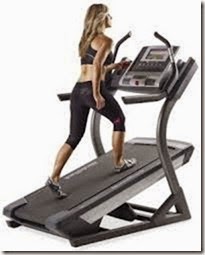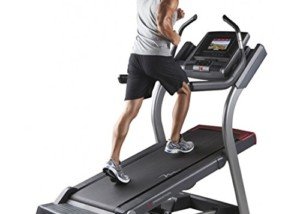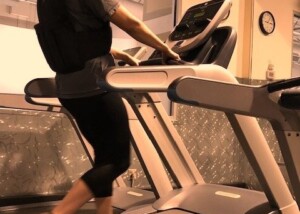
Step-by-step instructions in how to use a steep treadmill incline without holding on to get the most calorie burn and fitness benefits.
Every time I see a person using a high percent incline on a treadmill, he or she is grasping the bar in front or are gripping behind the display console.
This big mistake cancels out the effect of that huge incline.
When using a 30 percent incline and hanging onto the treadmill, the user will report that it’s impossible to walk this level of steepness without “falling off.”
If you’ve been using a steep incline and feel you must hold onto the treadmill, here is my question:
- What is the slowest speed you’ve ever used at this grade?
- My next question is: How slow can the machine be set at?
Think good and hard about your answers. If you stood on the incline but the belt was not moving (the treadmill wasn’t on), would you fall off? No. You’d be standing vertically and stable.
Now, march in place while on the high incline while the belt is still turned off. Do you fall? No.
Now, turn the machine on and set the speed at half a mile per hour and move your feet to keep up with the belt, but do not put your hands on the treadmill.
Keep them at your side, as they were when you were marching or as they’d be if you were walking this pace up a hill outside.
Do you fall? I’m betting you’ll come nowhere near falling off. That’s because your body is vertical and your legs are able to keep up with the very slow moving belt, even though it’s at a high incline.
Now gradually increase the speed, but do not advance it over that threshold to where your legs would not be able to keep up. For most trainees, that will be somewhere around 1.5 mph.
You won’t necessarily get out of breath at 1.5 mph, but unless your lower extremities are trained to move at considerable steepness, the back of your lower legs will fatigue quite quickly and you’ll be forced to take a rest.
What’s the best way to take a rest?
By lowering the incline. You can also increase the speed at this point. The lower incline will relieve your aching calves and Achilles regions.
When you reach the point of too much fatigue at a steep grade, do NOT hold onto the treadmill for the relief!
This “un-duplicates” a natural gait and trains your body to become dependent on an external support.
Instead, reduce the incline, even if this means waiting 30 seconds for the machine to sink down to 10 percent or even zero.
Be patient and wait, as you continue walking with a natural arm swing.
To get used to a 30 or higher percent incline, you’ll need to work it interval style:
Walk at 1 to 2 mph on it for five minutes (or three minutes, whatever it takes to fatigue you), and then reduce the grade to where you can walk comfortably for a few minutes (or three or four minutes; this isn’t engraved in stone). Then raise the incline to 30 again for another round.
- And all the while, your hands are OFF the treadmill.
- This is the only effective way to acclimate to such a steepness.
Over a period of weeks, you’ll note you can increase the speed slightly to achieve the same fatigue, and/or you must walk the high incline for longer and longer to stimulate the same fatigue.
You will never progress as long as you hold onto the bar or console, any more than you’d progress with chin-ups if every time you pulled yourself up, you received assistance from a gravity machine.
Be patient and remind yourself how you’d sustain a walk on a steep hill outside: without holding onto anything, and very slowly.
Intimidation of a “moving floor” is the biggest obstacle to keeping one’s hands off a treadmill. I can’t stress enough the effectiveness of just standing on an unmoving belt set to 30 percent.
Then march in place. Then turn it on to half a mile per hour, and begin walking.
Take my word for it: A 1.5 mph pace at 30 percent, maintained for 20 minutes, without holding onto the treadmill, will provide a nice introductory workout to incline walking.
You may think 1.5 mph is too slow, give this a try and you’ll be surprised!
 Lorra Garrick is a former personal trainer certified through the American Council on Exercise. At Bally Total Fitness she trained women and men of all ages for fat loss, muscle building, fitness and improved health.
Lorra Garrick is a former personal trainer certified through the American Council on Exercise. At Bally Total Fitness she trained women and men of all ages for fat loss, muscle building, fitness and improved health.


























